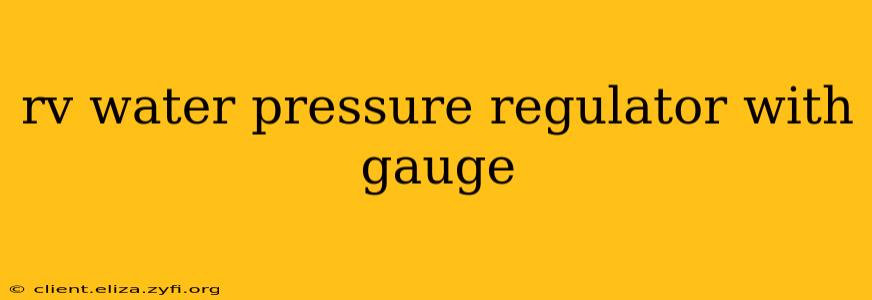Maintaining consistent water pressure in your RV is crucial for a comfortable and enjoyable camping experience. Fluctuations in water pressure can damage your RV's plumbing system and appliances. That's where an RV water pressure regulator with a gauge comes in. This essential device protects your RV's delicate plumbing from the potentially damaging effects of high water pressure at campsites. This comprehensive guide will explore everything you need to know about choosing, installing, and maintaining an RV water pressure regulator with a gauge.
What is an RV Water Pressure Regulator with a Gauge?
An RV water pressure regulator with a gauge is a device installed between your RV's water inlet and the campsite's water supply. Its primary function is to reduce the incoming water pressure to a safe and consistent level, typically between 40 and 50 PSI (pounds per square inch). The gauge allows you to monitor the incoming and regulated water pressure, ensuring optimal performance and protecting your RV's plumbing.
Why is it Important to Use an RV Water Pressure Regulator?
Many campsites supply water at pressures far exceeding what your RV's plumbing is designed to handle. High water pressure can lead to several problems:
- Burst Pipes: Excessive pressure can cause pipes and fittings to burst, leading to leaks and costly repairs.
- Damaged Appliances: High pressure can damage water heaters, toilets, and other appliances.
- Leaks and Drips: Even seemingly minor leaks can quickly escalate with high pressure, leading to water damage and mold growth.
A regulator prevents these issues by consistently reducing pressure to a safe level, protecting your investment and ensuring peace of mind.
What PSI Should My RV Water Pressure Be Set At?
The ideal RV water pressure is generally between 40 and 50 PSI. Going much higher significantly increases the risk of damage. Many regulators are adjustable, allowing you to fine-tune the pressure to meet your specific needs. Always consult your RV's owner's manual for recommendations.
How Does an RV Water Pressure Regulator Work?
The regulator uses an internal mechanism (often a diaphragm or piston) to control water flow. High-pressure water enters the regulator, and the mechanism reduces the pressure before it reaches your RV. The gauge displays both the incoming (unregulated) and the outgoing (regulated) pressure, providing real-time monitoring.
What are the Different Types of RV Water Pressure Regulators?
While most regulators perform the same fundamental function, there are a few differences to consider:
- Adjustable vs. Non-Adjustable: Adjustable regulators allow you to set the desired output pressure, while non-adjustable regulators maintain a pre-set pressure.
- Material: Regulators are typically made of brass or plastic. Brass is generally more durable but also more expensive.
- Gauge Type: Some regulators feature analog gauges, while others use digital gauges. Digital gauges offer greater precision but can be more susceptible to damage.
How Do I Install an RV Water Pressure Regulator?
Installation is generally straightforward:
- Connect to the Water Source: Attach the regulator to the campsite's water spigot.
- Connect to the RV: Connect the other end of the regulator to your RV's water inlet.
- Check the Pressure: Turn on the water and verify that the regulator is functioning correctly, maintaining pressure within the recommended range.
Always consult the manufacturer's instructions for specific installation details.
How Often Should I Check My RV Water Pressure Regulator?
Regularly checking your regulator is essential for maintaining safe and efficient water pressure. Inspect it visually for any leaks or damage before each camping trip. Also, periodically monitor the gauge to ensure the pressure remains within the recommended range.
How Do I Maintain My RV Water Pressure Regulator?
Regular maintenance is minimal. Ensure that the regulator is free of debris and that all connections are secure. If you notice any leaks or malfunctions, contact a qualified RV technician for repairs. Avoid using excessive force when connecting or disconnecting the regulator.
Can I use a garden hose pressure regulator for my RV?
While garden hose regulators might seem similar, they're generally not recommended for RVs. RV regulators are designed to handle the specific pressures and flow rates commonly found at campsites and are more robust. Using an incorrect regulator could lead to damage.
What size water pressure regulator do I need?
The size refers to the connection threads (e.g., 3/4" NPT). Check the size of your RV's water inlet and choose a regulator with the same connection size for a secure and leak-free connection.
By understanding the importance of an RV water pressure regulator with a gauge and following proper installation and maintenance practices, you can safeguard your RV's plumbing system and enjoy a worry-free camping experience. Remember to always consult your RV's owner's manual and seek professional assistance when needed.
